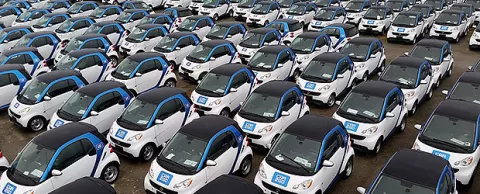
The very essence of how we get around cities is changing fast. Concepts like self-driving cars — or driving but not actually owning a car — might have seemed ridiculous a few years ago, but they are becoming serious factors that are shaping how we think about mobility.
The New York Times recently examined the latter factor — car-sharing services — an area where Daimler, a Council Global Lead Partner, has been a pioneer. Today, Daimler runs the world’s largest network of shared vehicles. Its service, Car2Go, boasts 2.4 million members in 26 countries — and more than 800,000 users in North America alone.
The profile contains some interesting information on the impact of such services, not just today’s impact, but the lessons that could prove useful in emerging areas. We’ve summarized some of the highlights below. — Kevin Ebi
1. Car-sharing services are catching on
Car-sharing services provide commuters new options — and they seem to be finding those options very attractive. In fact, usage data shows explosive growth.
In North America, there are currently 1.9 million people who are members of a car-sharing service. That is more than double the number of members from five years ago, according to a University of California Berkeley study.
2. The services are helping to lower emissions
Where car-sharing services are available, some residents are finding that they don’t need to own their own vehicles. A UC Berkeley study of Car2Go users in several cities found that as many as 5% sold their cars after the service became available in their city; an additional 10% decided not to buy a car.
By extension, people who don’t own vehicles drive less, so the services have resulted in fewer miles driven and therefore lower carbon emissions.
3. Convenience and choice matters
One of the things people find attractive about these services is that they have vehicles essentially wherever and whenever they want one. The fleets are generally large enough that when someone wants a vehicle, there is usually one nearby. Cars can be returned to virtually any street in the service area — they don’t need to go to a specific drop-off location. And vehicles can be rented by the minute.
A new trend, however, is to give people more choice in regard to the type of vehicle they rent. Car2Go began with a fleet of very compact, two-seat Smart cars. Daimler is now adding some luxury vehicles into the mix.
4. The data could prove valuable to cities
One of the more novel ideas is that the data collected through the use of the car-sharing services could help optimize the way that autonomous vehicles are eventually deployed.
Every time a car-share vehicle is rented, the services are able to collect information about where people are and where they need to go. In aggregate, that information and the ability to manage fleets to keep up with that demand could certainly have long-term applications.



